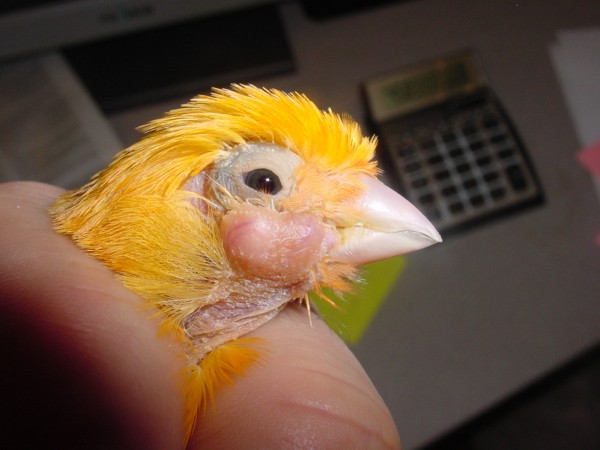Symptoms to watch for include skin lesions vomiting loss of weight even though eating normally and frothing at the beak. The most common fungal diseases are respiratory tract infections caused by Aspergillus spp and GI tract infections caused by Candida spp.
Canary Tales Nasal Sinuses Infection Feather Loss Around Eye
Macrorhabdus is an unusual fungus that affects the GI tract and occurs most commonly in small pet birds budgerigars lovebirds.

Canary bird diseases. Canary bird Serinus canaria with its typical yellow colouration. A bacteria causes the disease. Singer feet swelling bumble foot is a disease that is often found at the foot of the Canaries.
Inside of nests stained with yellow diarrhoea of nestling youngster stunted increased death rate first few days of life. Canarypox can enter human cells but it cannot survive and multiply in human cells. Droppings microscopic examination staining andor culture.
Genetic Diseases - Affecting primarily mutation andor in-bred canaries. Its not difficult though. It is the most dangerous and most widespread disease it can be transmitted with food clothes shoes and such.
Those that survive sometimes develop odd elongated beaks. Canary loses his appetite is thirsty relaxes his wings and tail has a diarrhea and his feces smells very unpleasantly. A little knowledge goes a long way.
Another disease more commonly seen in cockatiels is gastrointestinal yeast infection with Candida organisms. Bacterial And Fungal Skin Infections in Birds. The most common canary disease problem is.
Rickets which is found in growing birds - caused by an inadequate dietary intake of calcium phosphorous and vitamin D3 or improper calcium to phosphorous ratio. Aspergillosis fungal Disease bacterial infections pneumonia nutritional Deficiencies Hypovitaminosis A air sac mites upper respiratory infections bacteria mycoplasma inhaled toxins and lymphoproliferative disease Canary Pox. In the first stage bumble foot would look like a small pink pimples and is usually located on.
Occurs as two forms. Made of plastic bacterial infections fungal etc. Bacterial Diseases in Birds.
Solutions of the disease when the birds begin to recognize in bite of each other and show signs of hostilities and nervousness. Canarypox virus CNPV is an Avipoxvirus and etiologic agent of canarypox a disease of wild and captive birds that can cause significant losses. Bird owners in the Midwest or South where theres higher humidity are going to have a greater incidence of respiratory disease than bird owners living on the West Coast where its drier said Larry Nemetz.
Stools will be soft or watery and sometimes different colors depending on which of the canary diseases your canary may have. The symptoms are lethargy fluffed up feathers and loss of appetite. The incidence and types of respiratory disease seen vary depending on geography and whether the birds are kept in aviaries or as pets.
Avian Tuberculosis - Not often seen in birds but transmission to people can lead to respiratory infections swelling of lymph nodes below the jaw and even widespread disease in people with weakened immune systems. Respiratory Signs Chronic Depression Weightloss. This usually affects young birds.
Bacterial Infection of Small Intestines in Birds. Birds with yeast often regurgitate lose weight and have diarrhea and decreased appetite. It is unclear whether hepatic encephalopathy truly occurs in birds since nitrogenous waste is not the end product of hepatic metabolism.
Pseudo tuberculosis tuberculosis Canary is the most affected among other birds and more sensitive to it. Progression of the disease is very fast and die Canary by 100. Preventing disease in your canary and keeping him healthy is your most important task as a bird owner.
The disease can be treated with antibiotics and many birds pull through. Diarrhea can be a serious problem-- resulting in dehydration and malnutrition --if not dealt with quickly. The disease can spread through the air or through the feces from infected birds.
An awful lot of assumptions or opinions about the causes of this disease are less suitable perch eg. Birds on all-seed diets often become obese and develop fatty liver. The condition is not treatable and many birds die.
Important differential diagnoses include renal disease or renal failure hypocalcemia hypoglycemia hyperlipemic syndrome proventricular dilatation disease psittacosis atherosclerosis and lead toxicity. Fungal diseases are common in companion birds. Reduce the amount of greens offered.
Canker is a disease caused by the Trichomonad Protozoa and can cause death in canaries as well as other species of aviary birds. It can be brought in by a new bird or sometimes by overcrowding in a cage or poor hygiene. It is estimated that over 90 of pet canaries have the canary disease known as mites.
Beak And Feather Disease in Birds. Often they are a secondary infection in an already ill or immunocompromised bird. Sulfa AVS in water and soft foods egg and biscuit canary starter 2.
Canary Tales Mild Eye Problem Conjunctivitis
Canary Illnesses And Effective Medicinal Treatment For Your Pet Canary

All About Canaries Bird Diseases Of The Foot Of The Canaries

Diseases Of Songbirds A Cheat Sheet Lafebervet
Smart Canary Care Will Make Your Canary Bird Sing

Bacterial Diseases Of Pet Birds Exotic And Laboratory Animals Veterinary Manual

3 Ways To Spot Signs Of Illness In A Canary Wikihow
Canary Disease My Canary Has Inflated Legs Swollen Foot

Has Anyone Seen The Changes Described Below In Canaries


0 comments:
Post a Comment